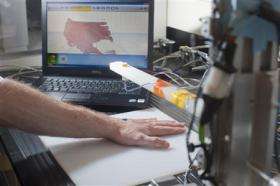A device used to bioprint skin onto burns demonstration. Image credit: Wake Forest Institute of Regenerative Medicine/Handout
(PhysOrg.com) -- A medical device that works rather like an inkjet printer is being developed in the US to heal burns and other wounds by "printing" skin cells directly onto the wound. The device, called a bioprinter, may reduce the need for skin grafts. It would be mounted on a wheeled frame and positioned over the bed of the patient.
A laser inside the bioprinter, which was developed at Wake Forest University School of Medicine in Winston-Salem, North Carolina, first measures the size and shape of the wound and then applies specific skin cells precisely where they are needed. The skin cell spray is produced by dissolving cells from pieces of skin and then separating cell types such as keratinocytes and fibroblasts. The purified cells are then incubated in a nutrient solution where they multiply. They are then placed into sterilized cartridges and sprayed onto the wound by a similar process to a multi-color inkjet printer, with the fibroblasts sprayed on first followed by a layer of keratinocytes. The sprayed-on cells form a protective shield for the wound.
The device has so far only been tested on mice, but the initial results show wounds heal quickly and safely, with wounds healing three weeks faster than those that were untreated. Professor of regenerative medicine at the University, George Christ, said the group would next test the device on pigs, who have skin resembling human skin. They will eventually apply for approval from the US Food and Drug Administration to allow them to carry out human trials. The team is also liaising with the US Armed Forces Institute of Regenerative Medicine with the aim of producing a device that could be used to treat wounded soldiers in Afghanistan and Iraq.
Victims of severe burns can die of infection within a couple of weeks unless if they do not receive skin grafts, but the grafts can leave serious scarring. In the bioprinter the skin cells became integrated in the surrounding skin, which the researchers said was probably because the sprayed cells included immature stem cells. Student Kyle Binder, who helped design the device said when the cells were put into the wound, they “know what to do”.
© 2010 PhysOrg.com



















